Official Site || Steam Page || itch.io Page
Ookibloks is what happens when you take the basic concept behind the types of sliding puzzles found in nearly any RPG with an ice dungeon, strip away the tedium, and apply it to a fast-paced arcade puzzle game. In this game you play as Ooki the monkey as he rapidly jumps between blocks to collect bananas while dropping fruit on enemies and using various objects to his advantage. It’s simple, it’s short, and it’s a whole lot of fun.
For a game which was originally launched for mobile devices, the gameplay and controls of Ookibloks translate over remarkably well. The world is broken up into nine areas with each area in turn consisting of ten stages and a boss fight. On his own, Ooki is only capable of flinging himself in straight lines until he hits a wall, but he can effortlessly stand on the bottom and sides of any block. Several of the blocks in every stage contain bananas and the goal is to collect every banana by making direct contact with their blocks. Ooki moves fluidly from block to block and flying through a stage as quickly as possible feels great. In fact, you are even encouraged to move as quickly and as often as possible because collecting bananas within a short amount of time increases the point combo multiplier and even bouncing between empty blocks which used to contain bananas will help to prevent the combo meter from completely draining if you need to wait for an enemy or an obstacle to move. You are further incentivized to move quickly because taking too long to complete a stage will cause Devil Cat to appear, an invincible monster who periodically rushes towards Ooki’s location. Hitting banana blocks, even empty ones, also adds notes to the already upbeat and catchy music, making the process of going through a stage perfectly not only feel great, but sound great too. As far as stage pacing is concerned, Ookibloks earns full marks for providing an experience which is constantly frantic and full of energy.
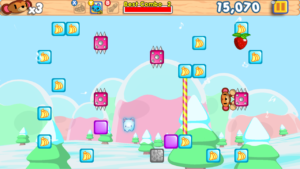
Lives and items are the two areas where Ookibloks hints at its mobile roots as these didn’t quite make the transition to the PC as smoothly as the rest of the game. Extra lives in this game feel even more pointless than in Mario’s more modern games. One hit from any danger will cost you a life and completely restart the current stage and lives are not refilled between areas, but you have infinite continues so the only penalty for running out of lives is that your score gets reset. However, even this doesn’t matter for anything beyond the Story Mode online leaderboards because you receive a rank on a per-stage basis based entirely on how many points you earned on a successful attempt regardless of how many times you died and, as far as I can tell, the overall rank received for an area is based entirely on the lowest rank earned between all of its stages; you can use a stage select to go back to any previous stage and retry it as often as you like so earning an S-rank on an area doesn’t require you to master all of its stages in a row. There are three consumable items in the game and both these items and especially the method for obtaining them feel out of place in this version. The least powerful of these items shoots out rockets which will make Devil Cat go away if they have appeared while yet another will temporarily make Ooki defeat any enemy on contact, which can trivialize some of the harder stages in the game. However, the final item is far and away the most overpowered as it will cause Angel Cat to appear and draw arrows to guide you down the exact path you need to take to collect each banana; you still may need to worry about timing to avoid enemies and hazards, but it may as well be a stage skip item and there isn’t even any apparent point penalty for using it. Actually obtaining these items is another matter entirely though because it involves the hallmark of a mobile game – daily challenges. Each day an NPC appears on the map who will let you take a challenge in the form of a stage you’ve completed with a twist, such as being required to collect every banana without losing your combo or beating the stage in the dark. You have unlimited attempts at completing the daily challenge, but this isn’t the end of the process as succeeding will toss you into a crane minigame where you have three attempts at collecting up to three capsules containing items or extra lives. The challenges themselves are interesting enough, but having items tied to a challenge which you can only complete once per day, to say nothing of the minigame which can lock you out of gaining any items at all for the day, feels completely out of place here.
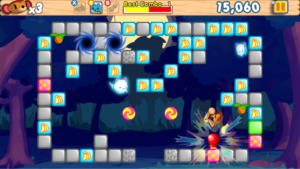
There is almost always more to each stage than avoiding enemies and collecting fruit. Four recurring objects are particularly important all they are all introduced soon after you start the game. Poles and spinners allow you to adjust Ooki’s position as Ooki will grab on to poles and can then slide up or down and launch off to either side at the height of your choice and spinners are only ever the size of a single block, but Ooki can be launched off of them from all four directions. Portals always come in pairs and they will transport Ooki and fruit from one portal to the other without a change in direction. Lastly, punch blocks can be just as much of an obstacle as a tool because they will immediately punch Ooki or fruit away from them when approached from any direction and they are often set up so that one block will punch you into yet another, making it difficult to tell just where you will end up if you don’t pay careful attention to how they are aligned. The presence of these objects allows for stages to require some pretty creative solutions and, even if you aren’t trying to go through the stage as quickly and efficiently as possible to maintain a combo for a high rank, there is often plenty of challenge to be had just in trying to figure out just where the path begins which will lead you to the last few blocks in a stage.
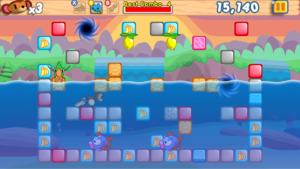
You may need to collect all the bananas in order to finish each stage, but other fruit is certainly more useful. Unlike bananas, other types of fruit grow along the ceiling and are needed for defeating enemies. Fruit itself does not count as a block, so Ooki simply passes through it rather than standing on it, but touching it will cause it to fall straight down and stun any enemy it touches for several seconds, at which point Ooki can defeat the enemy if he can touch it in time. As many stages require you to get rid of one or more enemies in order to reach every banana block, fruit regrows quickly after it is knocked down. However, it is not always as simple as waiting for an enemy to move underneath some fruit. Fruit will only hit a single foe after it falls, resetting the timer on any enemy it hits which is already stunned, and in some stages you may need to first avoid hitting enemies close to the fruit because Ooki might not be able to reach them along a safe path without first taking out a lower enemy. As fruit interacts with punch blocks and portals, the timing becomes far trickier if you need to account for the fruit bouncing between blocks or for the split second delay which occurs while teleporting through portals. Because fruit doesn’t necessarily grow on a block which Ooki can stop on, making your way to a stunned enemy to finish it off isn’t always easy and because knocking away enemies grants points and counts towards your combo multiplier the whole process adds in an extra layer of complexity and challenge when trying to figure out and properly execute upon the best path to take through a stage for a high rank.
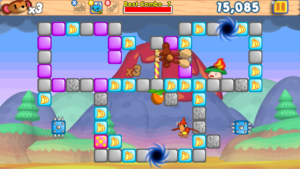
Every area focuses on a specific mechanic and/or certain enemy types to mix things up as you progress. Most of the enemies in the early areas aren’t particularly special and they simply move vertically or horizontally until they hit a wall and turn around or they crawl in a circle around a platform. Later enemies generally don’t have more complicated patterns, but they have much higher movement speeds and often react aggressively if they line up with Ooki, making them significantly larger threats and much more difficult to stun with fruit. The different types of blocks are what really make levels interesting though. Cracked stone blocks are by far the most common ‘special’ blocks and they will shatter if Ooki collides with them a few times. Sometimes breaking a stone block opens up a new path which you need to complete a stage, but at other times you can jump from cracked blocks to reach bananas which would otherwise require a much more difficult path, assuming you notice the optional shortcut before destroying the block, and at other times these blocks serve as safety nets after making a wrong turn and breaking one will cause Ooki to go flying out of the arena and lose a life. Ice blocks can be broken just like cracked stone blocks, but doing so always causes the ice to shatter and turn the block into a banana block, which sometimes just means that you need to bounce between blocks quickly to shatter and ice and collect the banana in time for the sake of maintaining a combo and at other times means you may need to take a tricky path to the block multiple times if there isn’t a block nicely lined up near it. Bent Pipes can be entered to change Ooki’s orientation by a fixed 90 degrees and stages with these blocks will sometimes force you to find a path both to inside the pipe and to standing on one of its two solid sides.

Hazard blocks also start to appear later on in the form of electric blocks which periodically will become infused with electricity and send out lightning between each other and hot blocks which will grow hotter and kill Ooki if you stand on them for too long. Combining both danger and utility are the rotating spike blocks, which have deadly spikes on two sides and safe surfaces on the other two; fruit can be impales on the spikes and then sent flying after the block rotates and if Ooki stands on one of the flat sides he will rotate along with the block, allowing for all sorts of complicated paths hidden in plain sight. As to my personal favorite type of block, that would have to be the water blocks which raise or lower the water level in some of the more aquatic stages. In addition to water reducing Ooki’s speed, making it more difficult to dodge around enemies, wooden blocks float near the top of water and the water blocks serve as a creative toggle to open some paths and close others indirectly by manipulating the height of the wooden blocks.
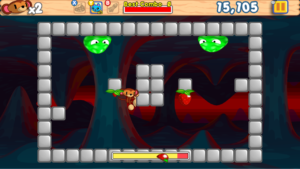
Everything about the core gameplay of Ookibloks is solid and entertaining, but there are unfortunately a few spots where the experience feels somewhat thin or could be improved. Most boss battles are far less enjoyable than the actual stages. While bosses look great and even get personalized shmup-style warning screens, they are usually nothing more than a chore to fight. Fights generally consist of a boss going through a very basic pattern as you wait for fruit to appear so you can hit the boss with it. The rule of three generally applies here with the boss going through the exact same pattern twice and then moving faster and possibly adding in a twist before you kill it with a third hit. It’s just a lot of waiting around and dying to a ‘surprise’ when the boss gets low on health means sitting through the often painfully easy majority of the fight a second time. You have some control over the order in which you go through the areas, but the ending is a bit underwhelming as there isn’t any sort of definitive final area. There is a ‘lost levels’ area with some extremely difficult stages, but with less than half a dozen even this doesn’t last long. Overall, the only piece of content which really stands out beyond the normal stages is a score attack mode where you have one stage based around each area with infinitely respawning bananas and a few powerups, such as a combo meter freeze, as you try to keep up a combo for as long as possible to get a high score on the leaderboards.
Even with a few rough edges on bosses and some of the optional content, the vast majority of the experience Ookibloks has to offer is ultimately so engaging and uniquely entertaining that it easily makes up for its shortcoming.